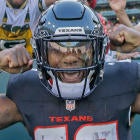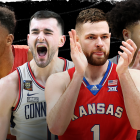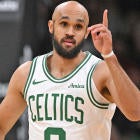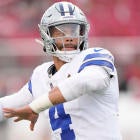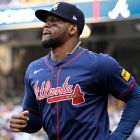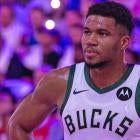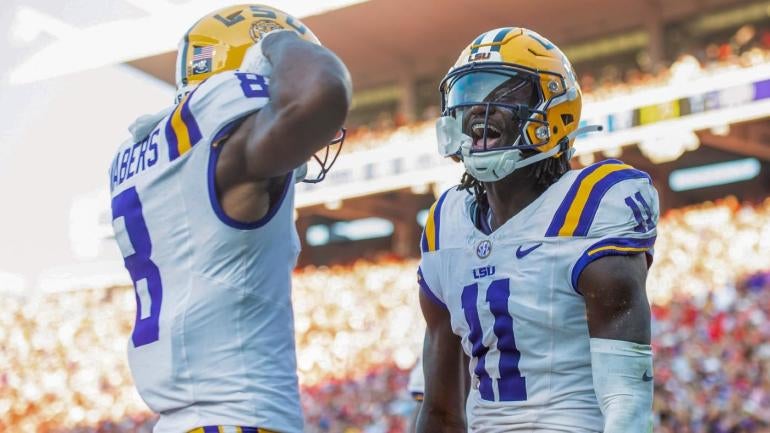
At this point of the NFL Draft process, the discussion, deservedly so, has become almost exclusively about the quarterbacks at the top. But not discussed enough is just how uniquely talented the top of this draft is aside from the quarterback position.
An effective way to project players, especially what their roles and styles may be in the NFL, is to use player comparison, as it can prevent the quality of the player from getting lost in a barrage of scouting jargon and not keeping perspective on what that player may be.
Here are player comparisons, albeit optimistic ones, for the best 20 non-quarterbacks in the 2024 NFL draft class.
Jonathan Brooks, RB, Texas: Joe Mixon
Coming off a midseason injury at Texas, Jonathan Brooks wasn't able to test at the NFL Scouting Combine or the Texas pro day, and he won't be 100% until NFL training camp. But that hasn't stopped teams from getting excited about him. Along with the elusiveness, explosive step when he has an opening and finishing burst, he's shown -- both on the field and during the interview process at the Shrine Bowl and NFL Combine -- that he can be an impact third-down pass blocker and pass-catcher, similar to Joe Mixon's impact early in his NFL career.
Marvin Harrison Jr., WR, Ohio State: AJ Green
A truly special prospect, Marvin Harrison Jr. can be compared to all sorts of future NFL Hall of Famers, including his father.
But A.J. Green, with his length, nuanced route-running, outstanding ball skills and smoothness as a perimeter receiver, is one that fits best from a talent and NFL projection standpoint. Expect Harrison to be a staple of the "NFL elite" receiver tier for the next decade.
Malik Nabers, WR, LSU: DJ Moore
Malik Nabers is incredibly dynamic and explosive, and his ability to accelerate before and after the catch is already among the best in the NFL. But maybe the most important trait he possesses is the ability to both finish vertical catches on the perimeter and not lose speed and balance when attacking the ball in stride. The latter two traits are what has made D.J. Moore such an impactful NFL receiver, and Nabers may be closer to the 2024 version of Moore than what he was earlier in his NFL career.
Rome Odunze, WR, Washington: Davante Adams
Unlike Brian Thomas Jr. (below), Rome Odunze's comparison is actually the easiest of this group. From his size, confidence in separating at the line and getting initial separation in all types of ways, and confidence you have him in when facing jump-ball and back-shoulder routes, he does everything Davante Adams has displayed in his NFL career. It's an optimistic comparison for sure, but it's why NFL clubs continue to rank Odunze as the second or third receiver in this class and would not be surprised at all if he's the top receiver in this draft class over the next three years.
Brian Thomas Jr., WR, LSU: Demaryius Thomas
Finding a comparison for Brian Thomas Jr. may be the hardest among this group of 20 elite prospects, in part because he has the skillset and speed of a smaller prospect (Thomas is 6-foot-4) and he plays with outstanding lower body strength despite being around 200 pounds. Demaryius Thomas had the elite athleticism as a perimeter receiver, the ability to win as a jump ball and downfield vertical pass-catcher, and the physicality to develop into a complete mid-field receiver. Thomas should make this a "top four" receiver discussion before the draft and during his rookie season.
Brock Bowers, TE, Georgia: George Kittle
If not for Kyle Pitts's struggles over the last two years, Brock Bowers slipping out of the top 10 would feel like a great misjustice in scouting. And especially considering Bowers and Pitts are very different prospects. Bowers can be an impact in-space blocker, capable in-line as a blocker and in short/mid-range routes, and has elite after-catch burst and creativity as a downfield route-runner. If he can go to an offense that can use him creatively, like the way Kyle Shanahan uses George Kittle, we'll be reminded quickly of how special Brock Bowers's talent really is.
Joe Alt, OT, Notre Dame: Nate Solder
At taller than 6-foot-8, Joe Alt has few peers historically of people who can move like him at that size. While current left tackle Kolton Miller for the Raiders is a common comparison for NFL clubs, I prefer one of the best left tackles of the past two decades in Nate Solder. Alt, like Solder, doesn't have the concern of being "too tall" to match up against small speed rushers thanks to elite bend and change of direction. And he has the potential to have the Hall of Fame career that Solder had as well.
Olu Fashanu, OT, Penn State: Ronnie Stanley
Not many offensive tackles have the length and foot speed as a pass blocker as Ronnie Stanley, but Olu Fashanu certainly fits that mold. Fashanu is one of the most-gifted offensive tackles of the last few years, and despite where he's currently mocked, he would've been the first offensive tackle taken a year ago and, like Stanley, will enter the NFL as one of the most-gifted pass blockers in the league.
JC Latham, OT, Alabama: Jawaan Taylor
Latham may end up as the second offensive tackle drafted, and there are teams that put him in contention to be the best in the 2024 draft class, including some near the top of the draft. His future may be at either right or left tackle, depending on which team drafts him, but like Jawaan Taylor, his sheer size and length alone will allow him to be a quality NFL starter with the potential to be one of the NFL's most-difficult blockers to get around on the edge.
Amarius Mims, OT, Georgia: Cam Robinson
It's hard to find a comparison for someone as massive and as athletic as Amarius Mims is. In most NFL Draft classes, he'd be the clear top offensive lineman. But this year, he'll land between the fourth and sixth taken. Like Cam Robinson, Mims' potential stems from his athleticism, size and flashes in college, but he'll need to go to a team that can be patient, develop him a bit, and allow him to figure out how best to use his traits against all types of NFL edge rushers.
Taliese Fuaga, OT/OG, Oregon State: Taylor Moton
Fuaga's natural strength and likely guard/tackle versatility is rare in the NFL Draft process, and it's why some NFL teams view him as one of the three best linemen in the entire draft. Like Moton, he can project to both tackle and guard for teams, depending on their scheme, but his power as a run blocker and ability to consistently win against power/bull rushes puts him in rare, NFL plug and play territory.
Jordan Morgan, OT/OG, Arizona: Dion Dawkins
Many teams have firmly shifted Jordan Morgan to a guard on their board, which may end up being a mistake. Like Morgan, Dion Dawkins size had teams potentially pushing him inside, but he's proven to be a franchise left tackle in his Buffalo Bills career. Morgan can certainly be an impact NFL guard, and has the foot speed and body control to win as a pass blocker on the perimeter or inside at guard. And whether he gets to play left tackle like Dawkins or not, he has the skill set to be an NFL starter.
Byron Murphy II, DL, Texas: Grady Jarrett
The real comparison that fans of Murphy (me included) want to say is Aaron Donald, but it's unfair to compare any player to the great defensive player of all-time. Grady Jarrett, a similar body type as both Murphy and Donald, is an easier comparison to digest and still highlight how special Murphy can be. Murphy has elite, top-of-the-draft talent that in most years would make him a surefire top-10 pick. He's a better prospect than Calijah Kancey a year ago.
Johnny Newton, DL, Illinois: Sheldon Rankins
Sheldon Rankins has been valuable since he entered the league eight years ago because, despite being a slightly undersized interior defensive lineman, he's show remarkable versatility and ability to win as both a gap shooter and reliable A and B gap defender. Newton has similar upside as a versatile pass rusher despite being a bit shorter than NFL average, and he can provide an immediate impact as a starter in multiple alignments early in his NFL career.
Jared Verse, EDGE, Florida State: Robert Quinn
Of all the talented players on this list, it's Jared Verse that is very likely going to go far too much later in the draft than his talent indicates, in large part due to the strength of the top of this class. Verse's comparisons are a lot exciting talents, including Myles Garrett, and Montez Sweat. But Robert Quinn is maybe the best combination of the athletic potential, hand strength and finishing ability as an edge rusher that most reminds of what Verse can be in the NFL.
Dallas Turner, EDGE, Alabama: Yannick Ngakoue
Dallas Turner put up incredibly impressive NFL Scouting Combine testing numbers, and his on-field ability matches the rare athletic upside he's shown in the pre-draft process. As a sub-250-pound edge rusher, his comparables are largely those who win as speed rushers and/or NFL rotational players. But the NFL edge rusher most aptly highlights the dynamic athleticism, and the immediate NFL impact of Turner is the former third-round pick Yannick Ngakoue, who's speed-rush ability allowed him to produce 30 sacks in his first three seasons in the NFL with the Jaguars. Turner can have potentially a similar impact early in his career.
Edgerrin Cooper, LB, Texas A&M: Darius Leonard
Arguably (and the most likely) top linebacker in the 2024 NFL Draft, Edgerrin Cooper has rare size, athleticism, explosiveness and range as a three-down linebacker. And through the draft process, from NFL team interviews at the Shrine Bowl through the NFL combine process, he's shown NFL clubs he's more than just a plus athlete at the position, but that he can handle being a three-position linebacker in the NFL. Darius Leonard was a "surprise" second-round pick but ended up being one of the best draft picks of the Chris Ballard era as the Colts GM, in large part because of Leonard's speedy development in the NFL and ability to add value on all three downs and from multiple linebacker alignments.
Quinyon Mitchell, CB, Toledo: Marshon Lattimore
The near-consensus top cornerback in the 2024 NFL Draft, Quinyon Mitchell has dominated the draft process and has elite man-coverage ability and the size and athleticism to be an impact cornerback. Like Marshon Lattimore, Quinyon Mitchell can anchor a defense as a cornerback in the NFL, and shouldn't last much further beyond the top-10 picks of the draft.
Terrion Arnold, CB, Alabama: AJ Terrell
Terrion Arnold, considered by most NFL clubs as, talent-wise, a near consensus top-three cornerback in this draft, showcases great press-coverage ability, plus top-end speed and finishing ability on the ball in coverage. Like A.J. Terrell, Arnold can contain and win as an isolation cover corner, with the potential to follow receivers across the field and adjust based on alignment, as well as finish and play with power as a tackler in run support.
Cooper DeJean, CB, Iowa: Kendall Fuller
Cooper DeJean has often been compared to either safeties or Jason Sehorn far too often, but people in the NFL who know DeJean's talent feel confident he's a cornerback first in the NFL. Kendall Fuller has shown the ability to play in man and zone defenses at a high level, slide into the slot depending on the matchup, and even adjust to more safety alignments in his NFL career. DeJean offers similar versatility as well as the ability to be an outside corner first in the NFL.








